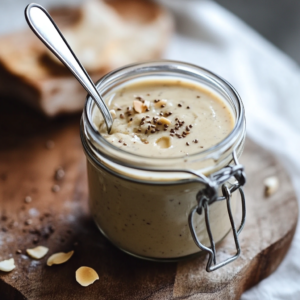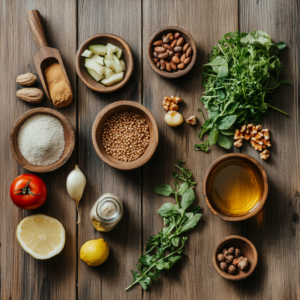1. Introduction
Every great vegan meal begins with a perfect sauce. Whether you’re drizzling creamy cashew cream over roasted vegetables or whisking zesty tahini dressing into a crisp salad, sauces bring dishes to life—adding layers of flavor, texture, and personality. In this guide, we’ll take you on a creative journey to master vegan sauces from simple pantry staples into unforgettable culinary experiences, transforming everyday ingredients into restaurant-quality drizzles. By the end, you’ll have the confidence and know-how to craft gourmet plant-based sauces at home.
What You’ll Learn
How to turn raw nuts and seeds into ultra-silky, savory sauces
Proven methods to batch, store, and preserve your creations
Tips for pairing sauces with grains, salads, bowls, and beyond
Strategies to tweak recipes for allergies, low sodium, or extra protein
Principles of sustainable sourcing to keep your kitchen eco-friendly
Whether you’re new to plant-based cooking or a seasoned vegan chef, this comprehensive guide is designed to be your go-to resource. Let’s dive in and start mastering vegan sauces—one creamy, dreamy drizzle at a time.
2. Why Mastering Vegan Sauces Matters
Master Vegan Sauces From simple pantry staples is a game-changer for any cook—vegan or not. When you master vegan sauces from just a handful of ingredients, you unlock a world of flavor, nutrition, and creativity.
Elevate Every Dish
A well-crafted sauce can transform plain vegetables or grains into a mouthwatering masterpiece. From drizzling over roasted Brussels sprouts to swirling into creamy pasta, your ability to master vegan sauces from basic recipes makes every meal feel special.
Boost Nutrition Effortlessly
Sauces made from nuts, seeds, and whole-food ingredients don’t just taste amazing—they pack a nutritional punch. Cashews contribute heart-healthy monounsaturated fats and plant protein, while tahini delivers calcium, iron, and antioxidants. Incorporating sauces you master vegan sauces from into your meals is an easy way to round out your nutrient intake without sacrificing flavor.
Spark Creativity & Customization
Once you understand the building blocks—creamy base, acid, seasoning, and thin-out liquid—you can adapt sauces to any flavor profile: Italian pesto, spicy chipotle cream, or tangy miso-ginger. This creative freedom keeps your weekly menu fresh and prevents recipe burnout.
Support Sustainability & Cost Savings
Homemade sauces eliminate the need for single-use plastic bottles and additives found in store-bought versions. Buying ingredients in bulk and preparing sauces in batches reduces packaging waste and can save you up to 50% compared to pre-made alternatives.
By focusing on sauces, you master a versatile skill set that elevates your entire plant-based repertoire—making every meal more nutritious, sustainable, and exciting.
3. Essentials: Tools & Pantry Staples
Before you begin, gear up with these must-have items:
High-speed blender or food processor for ultra-smooth creaminess.
Fine mesh strainer (optional) for an extra-silky texture.
Glass jars with lids (store sauces up to 5 days).
Measuring cups/spoons for consistency.
Pantry staples: raw cashews (soaked), tahini (sesame paste), nutritional yeast, lemon juice, garlic & onion powder, sea salt, black pepper, olive or avocado oil.
To see a full list of ingredients, check out our Vegan Pantry Essentials.
4. Cashew Cream Sauce
Ingredients:
1 cup raw cashews, soaked 4 hours or overnight
¾ cup water (adjust for desired thickness)
2 tbsp lemon juice
1 tbsp nutritional yeast
½ tsp garlic powder
½ tsp onion powder
Pinch of sea salt
Method:
Drain and rinse soaked cashews.
Combine all ingredients in a high-speed blender.
Blend on high for 1–2 minutes, scraping down sides, until ultra-smooth.
Taste and adjust lemon or salt.
Store in an airtight jar for up to 5 days.
Variations & Tips:
Herb & Spinach Cream: Add a handful of fresh spinach and 1 tbsp chopped basil.
Spicy Chipotle Cream: Mix in 1 tbsp adobo sauce from chipotle peppers.
- Vegan Alfredo: Stir in ½ tsp smoked paprika for a smoky twist

For a visual demo, see Pick Up Limes’ cashew cream tutorial: https://www.youtube.com/watch?v=5-CN6vMQa_s
5. Tahini Dressing
Ingredients:
¼ cup tahini
3 tbsp lemon juice
2 tbsp water (more for thinner texture)
1 tbsp maple syrup or agave
½ tsp garlic powder
Pinch of sea salt
Method:
Whisk tahini and lemon juice until thick.
Add water gradually until pourable.
Stir in maple syrup, garlic powder, and salt.
Refrigerate up to 1 week; whisk before use.
Variations & Tips:
Ginger-Sesame: Add 1 tsp grated ginger and a splash of sesame oil.
Herb Tahini: Fold in 1 tbsp chopped cilantro.
Beet Tahini: Blend in roasted beets for color and nutrients.

6. Other Must-Know Vegan Sauces
Tomato-Basil Pesto combines fresh basil, nuts, garlic, olive oil and nutritional yeast—perfect for pasta or sandwiches. Mushroom Gravy uses sautéed mushrooms, onion, garlic, vegetable broth and a thickener—ideal over mashed potatoes. Soy-Ginger Marinade blends tamari, grated ginger, garlic, maple syrup and rice vinegar—great for tofu stir-fries. To ensure your sauces cook to perfection, check out our comprehensive guide on Master Vegan Cooking Tips for essential methods like roasting, sautéing and seasoning for maximum flavor.

7. Tips for Sauce Success
Soak nuts thoroughly for smooth blending.
Use room-temperature liquids to prevent clumping.
Taste and adjust seasoning gradually.
Start thick—thin with water or plant milk.
Freeze portions in ice-cube trays for convenience.
8. Storage & Batch Preparation
Plan & Portion for Busy Weeks
Batch on the Weekend: Dedicate 30–45 minutes to whip up two or three sauces (cashew cream, tahini dressing, and perhaps a pesto).
Portion Control: Use ice-cube trays or ½-cup silicone molds for single-serve portions. Once frozen, pop cubes into labeled freezer bags for quick thawing.
Choosing the Right Containers
Glass Jars: Ideal for fridge storage (up to 5–7 days). Opt for wide-mouth Mason jars with airtight lids to preserve freshness.
Silicone Trays & Bags: Perfect for freezing. Silicone molds pop out with a twist; freezer-safe bags minimize freezer burn.
Thawing & Reheating
Quick Thaw: Place frozen cubes in a small bowl at room temperature for 10–15 minutes.
Gentle Reheat: Warm in a saucepan over low heat, stirring constantly. Add a splash of water or plant milk if needed.
Labeling & Rotation
Date & Sauce Name: Use waterproof labels and a black marker.
FIFO Method: First In, First Out—use older portions before newer batches to avoid spoilage.
With simple planning and the right tools, you’ll always have gourmet vegan sauces on hand—no last-minute scrambling required.
9. Health Benefits of Key Sauce Ingredients
Cashews are rich in monounsaturated fats that support heart health and provide plant-based protein for muscle repair. Tahini delivers calcium and selenium, crucial for bone strength and immune function. Nutritional yeast contributes B vitamins, including B12 when fortified, aiding energy metabolism. Lemon juice enhances iron absorption from leafy greens and adds a vitamin C boost. Incorporating these sauces into your meals not only enhances flavor but also ramps up nutrient intake. For more on plant-based nutrition, visit the Harvard T.H. Chan School of Public Health’s guide to healthy fats: https://www.hsph.harvard.edu/nutritionsource/what-should-you-eat/fats-and-cholesterol/
10. Pairing & Serving Suggestions
Grain Bowls & Grain-Free Swaps
Quinoa & Cashew Cream: Drizzle warm cashew cream over a bed of turmeric-spiced quinoa, roasted chickpeas, and steamed broccoli for a protein-packed bowl.
Cauliflower Rice & Tahini: Toss cauliflower rice with a splash of tahini dressing, fresh parsley, and toasted pine nuts for a light, grain-free side.
Salads & Raw Veggie Platters
Rainbow Salad: Combine mixed greens, shredded carrots, red cabbage, and edamame; top with ginger-sesame tahini dressing for bright, crunchy freshness.
Crudité Dip: Serve thick cashew cream as a dip for cucumber ribbons, bell pepper strips, and snap peas.
Hearty Comfort Foods
Vegan Alfredo Pasta: Heat cashew cream with garlic and nutritional yeast, toss with fettuccine, sautéed mushrooms, and baby spinach.
Loaded Sweet Potato: Roast sweet potatoes and drizzle with tahini dressing, chopped scallions, and a sprinkle of za’atar for Middle Eastern flair.
International Flavors
Mexican-Style: Add chipotle adobo to cashew cream for tacos, burrito bowls, or black bean tostadas.
Asian-Inspired: Stir soy-ginger tahini into soba noodles with shredded cabbage and steamed edamame.
By understanding complementary textures and flavors—creamy vs. crunchy, tangy vs. sweet—you’ll intuitively know which sauce to pair with each dish, making every meal balanced and memorable.
11. Customizing Sauces for Dietary Needs
Nut-Free Alternatives
Sunflower Seed Cream: Swap cashews for blanched sunflower seeds; soak and blend exactly as cashews for a neutral, allergy-friendly base.
Pumpkin Seed Pesto: Replace nuts with roasted pumpkin seeds in pesto recipes for added iron and zinc.
Low-Sodium Options
Reduce Added Salt: Omit added sea salt and rely on umami-rich ingredients (nutritional yeast, miso paste, capers) to enhance flavor.
Use Low-Sodium Tamari: Halve the soy sauce in marinades and replace with brewed mushroom broth for depth without excess sodium.
Oil-Free Dressings
Water-Thinned Tahini: Ditch the oil entirely; thin tahini with water and a touch of Dijon mustard for emulsification.
Vegetable-Based Creams: Add steamed cauliflower or potato to cashew cream for bulk and creaminess without oil.
Protein-Boosted Sauces
Silken Tofu Addition: Blend ¼ cup silken tofu into cashew cream for extra protein and a lighter texture.
Vegan Protein Powder: Incorporate a scoop of unflavored pea or rice protein into dressings—ideal for post-workout meals.
By tweaking just one or two ingredients, you can tailor each sauce to meet specific health goals or dietary restrictions—ensuring everyone at the table can enjoy your creations.
12. Sustainability & Ingredient Sourcing
Ethical & Eco-Friendly Purchasing
Fair-Trade Tahini & Nuts: Look for certified fair-trade labels to support farmers and promote sustainable agriculture.
Bulk Buying: Purchase raw cashews, seeds, and grains in bulk sections to minimize plastic packaging and reduce cost per ounce.
Zero-Waste Kitchen Practices
Repurpose Nut Pulp: After blending cashew cream, dehydrate the leftover pulp into crunchy granola clusters or mix into veggie burgers.
Compost Scraps: Save vegetable peels, lemon rinds, and herb stems for compost—returning nutrients to your garden or municipal compost program.
Seasonal & Local Ingredients
Seasonal Herbs & Greens: Use fresh basil in summer pesto, switch to parsley or dill in cooler months to support your local farmers.
Local Citrus: Buy lemons and limes from nearby growers to cut “food miles” and support regional agriculture.
Sustainable Packaging
Glass & Silicone Storage: Replace disposable plastic containers with reusable glass jars and silicone bags.
Refill Stations: Refill oils, vinegars, and spices at bulk-food stores to further reduce waste.
By making mindful choices—from ingredient sourcing to storage—you’ll minimize your environmental footprint while enjoying the freshest, most flavorful sauces possible.
13. FAQ
Q1: What Can I Substitute for Cashews if I Have a Nut Allergy?
If you’re allergic to tree nuts, blanched sunflower seeds make an excellent 1:1 replacement for soaked cashews. Sunflower seeds blend into a similarly creamy texture when soaked for 4–6 hours. After blending, strain through a fine mesh sieve for an ultra-smooth finish. For flavor, you can add a teaspoon of nutritional yeast or a pinch of smoked paprika to mimic the richness of nut-based creams.
Q2: How Long Will My Homemade Sauces Stay Fresh?
Cashew Cream: Store in an airtight glass jar in the refrigerator for up to 5 days. Freeze in portioned silicone molds for up to 3 months—then thaw at room temperature for 10–15 minutes.
Tahini Dressing: Keeps well in the fridge for 7 days. Always give it a good whisk before use, as separation is natural. Label each container with the preparation date to follow the FIFO (First In, First Out) method and prevent spoilage.
Q3: Can I Adjust These Sauces for a Low-Sodium Diet?
Absolutely. To reduce sodium without sacrificing taste:
Omit Added Salt and rely on ingredients like nutritional yeast, lemon juice, or capers for umami.
Replace regular tamari with low-sodium tamari or a splash of mushroom broth in any marinade recipes.
Taste incrementally—start with half the usual salt, then add more only if needed.
Q4: How Do I Incorporate These Sauces into Weekly Meal Prep?
By following the Master Vegan Sauces From approach in this guide, you can streamline your meal planning:
Divide cashew cream into ½-cup portions using ice-cube trays; freeze and pop out cubes as needed.
Portion tahini dressing into small mason jars for quick salad assembly.
Pair sauces with pre-chopped vegetables, grains, or protein sources (tofu, chickpeas) stored separately—then combine for instant, flavorful lunches.
Q5: Are These Sauces Suitable for Special Diets Like Keto or Gluten-Free?
Keto-Friendly: Both cashew cream and tahini dressing are low in net carbs when served in moderation. Use them sparingly over leafy greens and cauliflower rice to keep carb counts down.
Gluten-Free: All recipes here are naturally gluten-free. Always check labels on tamari or spices to ensure no hidden gluten.
For more meal-prep strategies and allergy-friendly tips, visit our guide on Vegan Pantry Essentials.
14. Conclusion & Next Steps
Recap & Key Takeaways
You’ve learned to Master Vegan Sauces From two foundational recipes—silky cashew cream and tangy tahini dressing—and explored other versatile sauces like pesto, gravy, and marinades. Equipped with essential tools, pantry staples, and batch-prep techniques, you can now create flavorful, nutritious sauces that elevate every meal.
Put It Into Practice
Block off a “Sauce Sunday” to batch-prepare your favorite sauces. Portion them into freezer-safe molds or glass jars, label with dates, and experiment throughout the week. Drizzle cashew cream on grain bowls or blend tahini dressing into fresh salads. Use variations—chipotle, beet, or herb-infused—to keep things exciting.
Join the Community
Have you tried these sauces? Share your results and tips in the comments below or tag us on Instagram with #VeganSauceMaster. For advanced techniques—like roasting nuts for deeper flavor—visit our Master Vegan Cooking Tips guide.
Subscribe for Weekly Inspiration
Stay ahead of the curve—join our newsletter for exclusive vegan recipes, seasonal sauce hacks, and expert cooking tips delivered straight to your inbox.
Affiliate Offer
CURIOUS TO GO DEEPER? ENROLL IN THE VEGAN SAUCE MASTERCLASS FOR STEP-BY-STEP VIDEO TUTORIALS, EXCLUSIVE RECIPES, AND PERSONALIZED FEEDBACK: [INSERIR LINK DE AFILIADO AQUI receita molhos vegano]
By applying the strategies you Master Vegan Sauces From, you’ll transform ordinary ingredients into gourmet experiences—boosting flavor, nutrition, and sustainability in every bite.